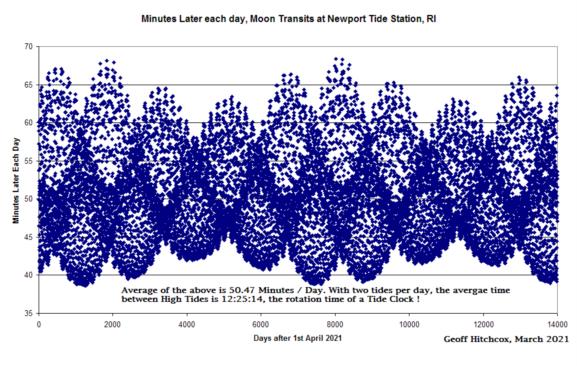
NavList:
A Community Devoted to the Preservation and Practice of Celestial Navigation and Other Methods of Traditional Wayfinding
From: Geoff Hitchcox
Date: 2021 Mar 27, 01:28 -0700
Alexandre Eremenko quoted from the book, Julian Stockwin's "Quarterdeck"
" the moon will cross just forty-nine minutes after the sun does, and falls back this time for every day. After that it's easy."
As soon as I read the above Alex, I thought to myself - a better choice would have been 50 minutes !
I thought some "hard data" might show us how accurate the " 49' " is, and also how much the Moon varies as it transits day after day from any set location.
I chose a location:
Tide Station at NewPort, Rhode Island
-71.326062 ; LON
41.504341 ; LAT
3.0 ; ALT (metres)
Using the JPL DE430 Ephemeris, I derived the transit time of the Moon from the above location for the next 14,000 days (so includes 2 x 18.6 Year Lunar Cycles), from this I then calculated how much LATER the Moon would transit each day.
I have attached my RAW text file, if you want to have a play with the numbers (or check my work ;-) .
I also show the results below in graphical form.
The average of these 14,000 transits is 50.47 Minutes - and this should ring a bell with anyone who has a (non harmonic) Tide Clock - whose hand takes an extra 50.47 Minutes ( 50 minutes 28 seconds ) each day to rotate twice compared to a standard clock.
So you can see Alex why I thought "50" is a better number, it's also easier to multiply than "49" out there in the middle of the Ocean with only a watch and a good memory of how many days have elapsed since the NEW Moon.
However the transit time from day to day, is not always an extra 50.47 minutes, in the attached file it varies from 38.62' to 68.36' over the 14,000 transits.
However, the "rule of thumb" mentioned in the book, would be "good enough" to roughly find South (or North) given the circumstances.
You may be interested in a post I did last year that talks about the Moon and Tide Clocks Alex.
Regards,
Geoff Hitchcox
Christchurch,
New Zealand.








